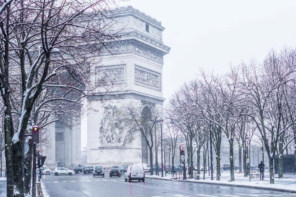
“I’ll pick you up at 6:00 am. Make sure to wear closed-toed shoes.” Gulp. No turning back now. Should I also be packing my whip? There was no way I wasn’t going to visit Angkor Wat without doing it right … à la modern day Indiana Jones.
This would be my third trip to Southeast Asia, however, this time around I wasn’t sure when exactly I’d be coming back. Therefore when I was trip planning, there was ultimately one place I absolutely would not miss: the legendary temples of Angkor Wat.
The ancient capital of the Khmer Kingdom, Angkor reached its peak from the 11th to 14th centuries. Known for its amazing temples, which once numbered over 1,000, these plus the since vanished surrounding houses and commercial buildings made it the largest pre-industrial city in the world with an estimated population of a million people. Victim of centuries of sackage, ravages of time and forces of nature, today around 70 major temples and 100 minor temples have been restored, whereas many still remain buried or hidden.
During my hasty trip planning back in October, though I’d squeezed Luang Prabang into my itinerary, there was no way its inclusion would sacrifice Angkor. This would be the second leg of my regional expedition. When I’d first started thinking about my trip, I’d gotten a few tips on visiting the temples from my friend Preston of Paris by the Glass, who’d recently been there.
He advised me to take at least three days to do the temples, to start early (ugh! I hate getting up early!) and that I could get a guide on site or just use my guidebook to tour around, he even had a tuk tuk driver recommendation. It didn’t seem like I’d have to do much advance prep. Yet, would that suffice to quench my intellectual appetite for Angkor? Perhaps it would be worthwhile to at least find a recommended guide or tour for part of the trip so I could get enough historical and cultural context, I just didn’t have an ounce of time on the hectic work portion of my trip. Luck or fate would have it otherwise.
Back in Luang Prabang when I was finally slowing my mental speed down and catching up on personal internet-ing, an article on the world’s best tour guides crossed my virtual path and who was at the top? An expert Angkor guide, a Belgian bioengineer, cartographer and photographer Stéphane de Greef… a true modern-day Indiana Jones.
He looked perfect, but surely he’d be booked up so close to the date… well, nothing ventured, nothing gained. Email sent, a few more exchanged and voilà I had a tour date and was the happiest person on the plane to Siem Reap.
Since I couldn’t afford to tour with Stéphane for my whole three days, we’d decided over email that I’d take on some of the big name parts of Angkor on my own on the first day, then we’d visit his favorite, more secret parts together on the second.
Getting going at a “leisurely” start at 7:30 am on my first day, out with the tuk tuk driver recommended by Preston. Besides going off with the wrong tuk tuk driver between two of the temples, tracking down my correct driver just as I thought I’d be stranded and have to sleep in the crook of some giant tree roots and uncozy blocks of stone, I had a great intro day and managed to visit Angkor Wat and many of the larger temples of Angkor Thom including Bayon, the Elephant Terrace, the Terrace of the Leper King and Ta Prohm, made famous by the Tomb Raider film. While these “big name” temples are splendid and not to be missed (Ta Prohm, with the forest’s attempts to reclaim the stone, really is awe-inspiring), I was in for a greater adventure and amazing Angkor experience the next day.
There was a gentle mist rising from the marshy fields as we approached the Angkor forest that second morning at around 6:30 am. I gazed up to find the staring eyes of one of Angkor Thom’s classic four headed gates, this lesser-used entrance held up with large timber planks, the complexions of the crumbling heads covered in a skin of green moss. Like most fortresses, there used to be a moat around the fortified walls. Some stretches are still hugged by pools of water, like the one we were crossing, that morning with a few quiet fisherman perched by its banks casting out their lines.
We bid our driver a temporary farewell and entered the mouth of the gate on foot. Stéphane veered left, scaling the small hill on the opposite site of the imposing entrance. We were on top of what was once the mega-city’s mega-ramparts. All alone. Save for a few stray cows, fluttering butterflies, marching ants and industrious termites, the fascinating flora and fauna of Angkor were as much a passion for Stéphane as its cultural history and I was introduced to both along our quiet forest path.
Reaching a corner in the walls, we rounded the bend to come upon a first temple. There atop the walls, unearthed yet “invisible” to most visitors to Angkor. Here Stéphane put on his cartographer’s hat to enlightened me to the geography of the site and how contemporary mapping techniques have led to the discovery of such temples in addition to shedding more light on the Khmer empire society.
“See these darker squares,” Stéphane instructed, pointing to some satellite images on his iPad. “These were all civic buildings.”
Thousands of structures which had not withstood the test of time. We saw more examples of what was beneath the moist soil of the forest in the remains of bits of glass and pottery, what still hasn’t been uncovered is immense and enlivens any archaeology lover’s imagination. This hidden, “run-down” side of Angkor is what makes it so special, so magical. Visitors can wander around much of the site almost as if they’d stumbled upon the ancient ruins themselves, that said, many would never find the treasure’s in Stéphane’s vast knowledge of the site.
We carried on our hike, taking in the serenity of the natural surroundings and stopping to peer at some curious beetles or millipedes. A local passed us on a bicycle. We spied on some water buffalo taking their morning bath. I heard more about Stéphane’s various projects and his previous work on the still mammoth mission of demining the country following its decades of turmoil.
“Don’t worry,” reassures Stéphane, possibly sensing my slight concern about the subject, or rather my mother’s. “The park and these paths have been demined and are completely safe.” Angkor might be safe, nevertheless, the country still has millions of unexploded landmines. He suggested I stop by the Cambodian Landmine Museum to learn more about this the next day on my way to Banteay Srei temples.
Coming up to a bridge, we crossed over the “moat” to our next temple. Larger than the first, here we actually ran into a few of the more adventurous tourists who’d ventured this way. Stéphane was taking me to a surprise.
Our seemingly aimless path underneath collapsing archways and around tittering columns engraved with voluptuous dancers led us to a small room where we found an elderly woman. A Buddhist nun? Stéphane said she’d been there for years, blessing visitors, offering them a thread bracelet for protection for a small donation in return.
“A little piece of happiness for your day,” said Stéphane. How could I be happier than I already was? It was possible and one look at the little bracelet kept me uplifted the rest of my trip.
We forged back into the forest, hiking in the silence broken only by some chirping birds or a new insect spotting, thank goodness no Indy-style pits of snakes or ants. We did traverse the edge of a liftlock to pass over a river which was somewhat harrowing, yet with no “bad guys” in tail.
We emerged out of the trees to rendezvous with our driver on the main road to take us on to our last temple. Again similar to the last one, it had very few visitors milling about and echoed a similar charm to the Ta Prohm, with hungry trees and moss consuming the remains of the temple, yet this one was much removed from the standard tourist circuit.
Though we’d been walking for 6 hours and my feet were grateful for the rest on our journey back to Siem Reap, I didn’t want to be pulled out of my unforgettable Angkor Adventure with Stéphane and return to civilisation. I’d try to carry on my own discoveries the next day based on Stéphane’s advice, but it wasn’t quite the same without expert insight.
My first mistake might have been bothering to go to Angkor for sunrise, without sunny weather forecasted, there practically wasn’t any point, and with the hoards of tourists crowding around, I really should have looked into (or picked Stéphane’s brain) as to better options.
However, I didn’t regret going on the Banteay Srei temples. Made of a reddish stone, constructed in the second half of the 10th century, the site predates Angkor Wat. The morning brume was especially atmospheric here creating a dream-like aura around the intricate carvings decorating the temple walls. There weren’t many people first thing at 7:30-8am, but tour buses were piling into the parking lot at 8:30-9 am when we were leaving, perhaps getting up early for the botched sunrise hadn’t been such a bad idea after all.
En route to a few more pre-Angkorian temples, I did have my driver stop at the Landmine Museum, a powerful and saddening experience of the tragic consequences of war. As much as it was disheartening, it left me wanting to learn more and understand the modern history of this country as much as I’d spent discovering its “ancient” history over the last few days.
I pondered this along our bumpy highway as we captured some essence of today’s Cambodia; children biking to school, others lounging under the canopies of their modern versions of traditional Cambodia style houses, a family preparing for some sort of celebration. Even though I’d wanted to spend as much time exploring the temples I did repent not being able to connect as much with the locals as I had in Laos (well, someone had tried to make friends with me… a lesbian masseuse in the massage parlour I’d gone to that evening to sooth my aching feet, fending off her advances I befriended a nice Vietnamese girl a few chairs down who’ll appear in a later story).
That said, sometimes we just have to go with the flow, the plots of an Indiana Jones movie are filled with surprises. Here I’d connected with a foreigner who’d created a strong bond with the country, just as I’d done with France. He was a different sort of cultural conduit. On another trip, I’d travel to more offbeat parts of Cambodia to make up a better picture of the country… and possibly get rewarded with that nice sunrise, or either way, build on the knowledge and dreams that I’d acquired on this special trip.

You can follow Stéphane’s latest adventures and insect finds on his Facebook page or find out more on his tours and projects here.




























































